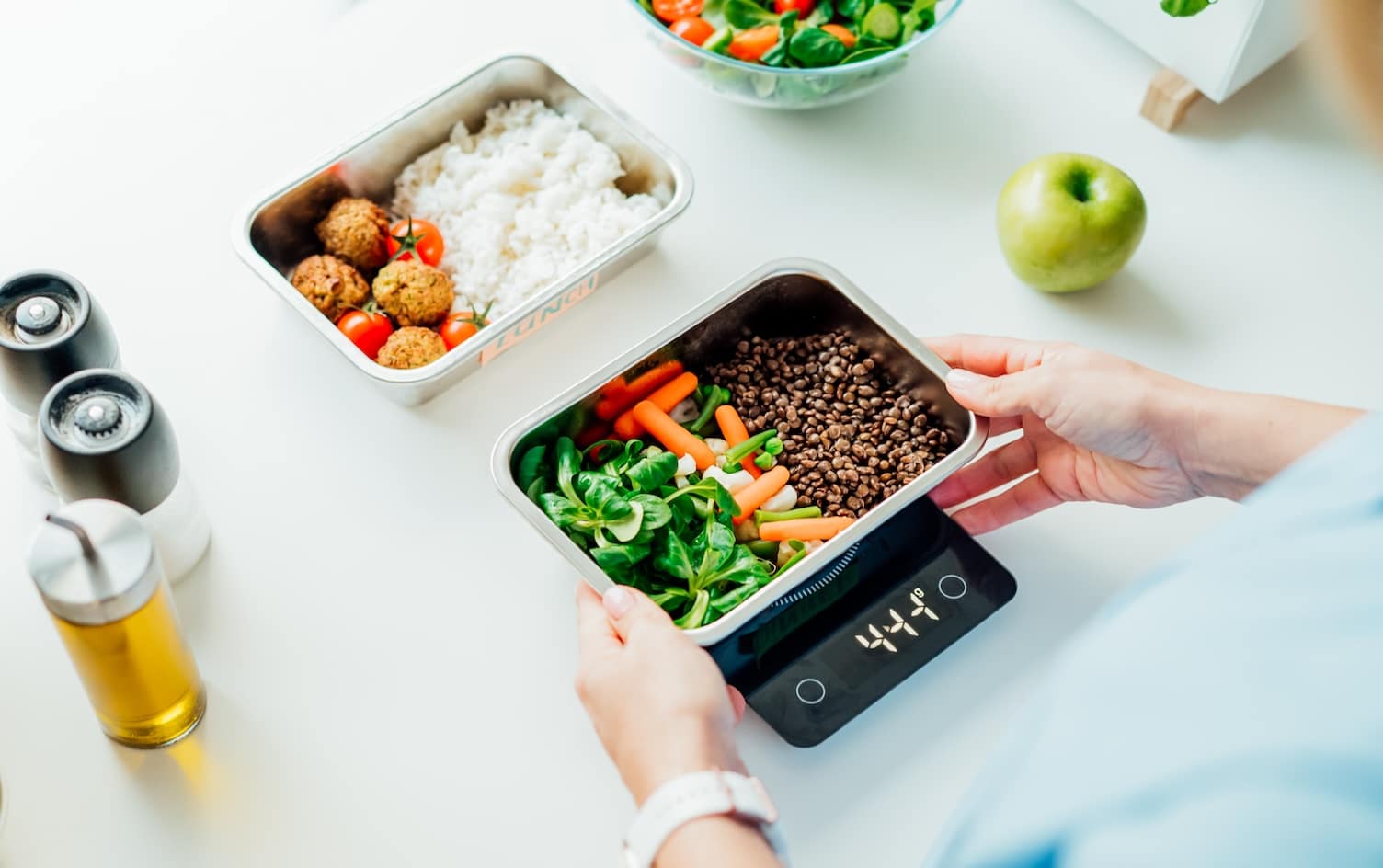
[ad_1]
Weighing your food can be a great way to eat the right portion sizes while on your weight loss journey. A trusty food scale can help you measure ingredients to the recommended serving size printed on nutrition labels, so you don’t accidentally eat more than you need to feel satiated.
With that said, should you weigh food portions before or after cooking? Turns out there is a difference, and here’s why.
How Does Cooking Alter the Weight of Your Food?
People tend to eat more when they’re given larger portions, even if they’re already full.
If you weigh food for weight loss, you’re probably doing it to stick to specified portions from the food label or a personalized eating plan. So, if you’re already making the effort to measure out your food, you want to make sure that you’re doing it right.
Many raw ingredients change weight during the cooking process. A food calorie scale can give you a good look at the raw weight and calorie count of ingredients before cooking. Whether the food becomes lighter or heavier after cooking depends on the ingredients and cooking method. Not only that, but food can also change in nutritional value.
How cooking methods and temperatures alter food weight
Different types of foods will react differently to heat and methods of cooking.
- Sautéing veggies and proteins will cause the cooked weight to be less than the original weight.
- Raw vegetables weigh less once you heat them because you’re cooking off some of their water content. They may also lose some of their nutrients along the way, but veggies are still great for you whether you eat them raw, steamed, boiled, or sautéed.
- The weight of meat changes with heat, too, due to its fat and water content. Raw chicken shrinks about 25% during cooking, and you’ll notice a difference in the size of a chicken breast before and after.
The cooking weight of most foods is usually lower than the raw weight.
While this isn’t always precise, knowing this before you start measuring food for cooking will help you be as accurate as possible in your diet. Weighing your food beforehand can help you measure more exact portion sizes, helping you to stay on track.
How seasoning and recipe ingredients can alter food weight
Adding fresh herbs and spices to your food is a great way to boost the flavor of any dish. Many spices also have health benefits and nutritional properties that can help with your weight journey.
These food items usually have little effect on caloric intake or the food’s weight since you’re only using a small amount of them. But that doesn’t mean everything you add to your food will have the same effect.
Some recipes can change weight during cooking when you add heavy ingredients, like cream, sauces, or breading. Not only do these ingredients make food heavier, but they often come with extra calories and fat you probably don’t want when trying to lose weight.
Benefits of Weighing Your Food Before Cooking
So, you want to know how to weigh food the right way? Weigh your food raw. This lets you know right away how much your serving size is.
Start by using the best food scale you can find specific to your weight loss goals. Yes, there are scales designed for weight loss. There are even scales that connect to MyFitnessPal for automatic logging! It should let you measure in grams or ounces and have a large surface for weighing.
When you turn on your scale, it should be at zero. Once you set everything up, you can weigh the ingredients.
Here’s how weighing your food with a good scale can impact your weight loss efforts:
Helps with the accuracy of your macros and weight-loss efforts
When you weigh food either raw or cooked (even though raw is best), it can help you with portioning and calorie counting.
For example, once you measure your food, enter the raw weight and any seasonings or pre-cooking altering into your food tracking app. Again, some scales may automatically do this, which is a big help.
Apps and calculators like MyFitnessPal will tell you how many calories are in foods, as well as essential macronutrients like carbs, fat, and protein.
Matches nutrition facts with packaging and tracking apps
You’ve seen nutrition labels on packaged products your whole life, but you might be surprised by what those serving sizes actually look like. For example, a standard serving of cereal is about 30 grams (four or five tablespoons), which is probably less than what you’re pouring into your bowl in the morning.
If you’re serious about your nutrition, it can be helpful to weigh ingredients instead of eyeballing them. To check whether you’re matching what the nutrition label calls for, weigh out dry items like rice, pasta, and other grains and legumes.
Food scales also complement nutrition-tracking apps like MyFitnessPal. The more accurate your input is, the more exact your nutritional data will be. If you know exactly how much pasta you cooked, you’ll see just how many calories, protein, carbs, and vitamins you consumed.
What Should You Consider When Weighing Cooked Food?
It’s easy to measure out food and ingredients when you’re the one doing the cooking. Things might get tricky when you’re eating something prepared by someone else. When this happens, you’ll have to use your best judgment.
If you’re eating takeout, for example, you could weigh your meal to get a better read on serving size (even though it’s already cooked). If you visited a restaurant or ate at a friend’s house, check your tracking app to see if there’s a similar entry you can use; if there isn’t one, you can track individual ingredients you know are in the food.
Just remember: Eating healthily isn’t an all-or-nothing journey. It’s about being as accountable as possible while living and enjoying your life.
Boost Weight Loss With Effective Calorie Intake Tracking
Studies show that people who track their food, like through food measuring, are more likely to lose weight. MyFitnessPal makes it easy to track all your favorite foods with just a few taps. Whether you’re counting calories, macros, or both, seeing your eating habits (and gaps!) is valuable insight when it comes to weight loss.
Give your weight loss a boost and download the MyFitnessPal app today.
Originally published January 18, 2020; updated April 10, 2024
[ad_2]






